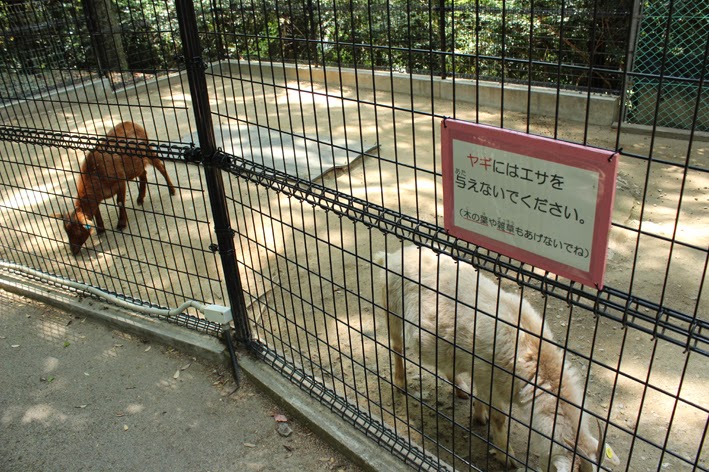Satsukiyama
Zoo in Ikeda City ,
Osaka Prefecture
From Tasmania
The photo below shows Wandar
(female), a Naked-nosed Wombat (Vombatus Ursinus). According to the IUCN’s red list of
threatened species, a 2008 assessment rated the threat to this particular species
of wombat as being of “least concern”, stating that this type of wombat was
common and that the population trend of this animal was stable.
Bennett’s wallaby (Macropus rufogriseus). A 2008 IUCN assessment also rates the threat to this animal as being of “least concern”.
Wallaby
enclosure. Given the relatively small
size of the wallabies, this exhibit seemed to be fairly large, with enough space
for them to hop back and forth over an open ground.
The Town Mascot
In
the shopping arcade located nearest the zoo, I couldn’t find any directional signs
leading to the zoo. I did, however, find
a number of wombat statues and signs featuring a wombat character. The wombat
appears to have become the mascot of Ikeda
City
Shopping
arcade
Statuette
on a bench
Statuettes
on a postal drop box
Besides
the wombats and wallabies, most of the other animals at this zoo are of the
domesticated type (sheep, goats, alpacas, pigs, rabbits) that you would normally
expect to find on a farm. Much like on a
farm, although the enclosures for these animals were not that big, the animals
did not show any particular signs of distress or discomfort.
Alpaca
(Vicugna pacos) enclosure
Emu
(Dromaius novaehollandiae)
Goats
Sheep
(Ovis aries)
Patagonian
Cavy (Dolichotis patagonum)
Educational Efforts
Despite its small size, this
zoo had a substantial educational room that included information regarding wombats
as well as birds and small animals native to Japan
This
exhibit had a lot of information about wombats, including photos of each of the
wombats who lived at Satsukiyama.
The
display on the opposite wall includes taxidermy specimens of small mammals,
birds, and insects native to Japan
The
below skeleton on the left is “Satsuki”, a female that passed away at the age
of 19 years old. The taxidermy specimen
on the right is “Ayaha”, a female that lived until she was 5 years old.
This
framed set of bones is “Teia”, a female that died at 14 years old.
The
pelt in the case below belonged to “Satsuki”, the 19-year old. Apparently her bones and pelt were separated. The hole in the middle of the Plexiglas case
allows visitors to touch the pelt and experience the texture of wombat fur. To the right of the case is a shipping crate
that was presumably used to bring the wombats to Ikeda City Gold Coast , Australia
The Convict
The animals in this collection
seemed to be in good condition. The one possible
exception might be the raccoon. I don’t
think that Japanese people particularly dislike raccoons (in fact a 1970’s
anime featuring raccoons was very popular), but I do think that raccoons have
an image problem. Perhaps it is because they
raid farmers’ fruit orchards and vegetable gardens and are considered serious
agricultural pests. Perhaps it is
because they have been designated by the Japanese government as a harmful
invasive species, and are therefore considered unwanted illegal aliens. Perhaps it is because they have masked faces
and look like bandits that belong in a jail.
At a number of zoos that I have visited in Japan, the raccoon enclosures
have somehow reminded me of jail cells, with minimal features and only concrete
floors.
This
particular raccoon had the smallest enclosure in this zoo.
The
raccoon had bald patches on its back which appeared to be the result of biting itself.
I don’t know if this was a temporary
state or the animal’s usual condition. I
also don’t know whether this was the result of fleas or stress. Whatever the
cause, it was sad to see.
Opportunities for
Animal Encounters
There was an area where
visitors (mostly children) could touch rabbits, guinea pigs, turtles, and
chickens during the time periods from 11:00 to 12:30 and from 13:40 to 15:00.
Besides
this special area, almost all of the other enclosures (except for the wombat
and raccoon enclosures) seemed designed to allow visitors to feed the
animals. Posted signs asked that visitors
only give the animals food sold by the zoo, and coin-operated dispensers
located throughout the zoo had feed pellets available for 100 yen. Although separated by a fence or railing,
visitors could have direct contact with the wallabies, goats, sheep, alpacas,
and emus.
Food and Souvenirs
There
was a park information house (below photo) with a small store near the zoo
entrance that sold foods such as takoyaki and ice cream. They also sold small stuffed animals. The only products with the Satsukiyama Zoo
name and logo were postcards and plastic file folders.
The
nearest train station is the Hankyu Ikeda-shi station. At the station, there were no visible signs
or billboards specifically advertising the zoo, and no directional aids leading
to the zoo. Visitors should prepare
themselves with a map and perhaps a smart phone equipped with a GPS
application. From the station, it is
about a 1-kilometer walk up a gentle slope to the Satsukiyama Park
(Note:
All photos taken in this post were taken during a visit on May 6, 2013. The comments in this post are based on
observations made on that day.
Conditions may have since changed.
Please check it out for yourself!)
































No comments:
Post a Comment
Note: Only a member of this blog may post a comment.